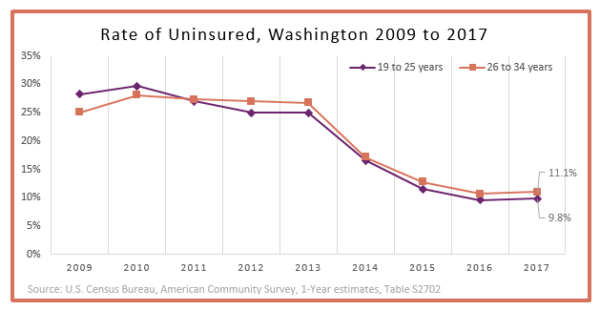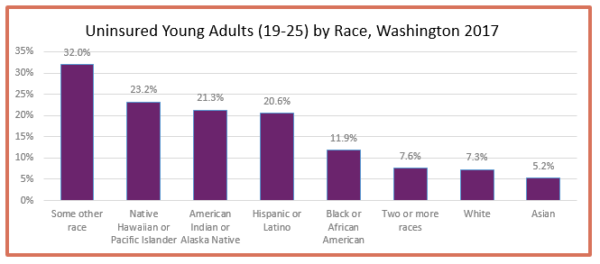A few days after the cake, candles and celebration of her 26th birthday, Larkin Sheldon of Seattle, Washington awoke uninsured. Her small Seattle-based employer didn’t offer insurance, and she could no longer stay on her parent’s plan. She checked out options on Washington’s Health Benefits Exchange, but was put off by confusing terminology, hidden fees, and monthly premiums that exceeded 11% of her monthly income.
Larkin took a gamble on remaining young and healthy. Months later, a twisted knee and audible ‘POP’ left Larkin hobbled, in pain, and ‘freaking out.’ The next day, Larkin enrolled in health coverage and began the three-week wait for her new coverage to activate. Today Larkin pays over $400 a month for coverage. Although she now has access to her doctor and a sense of comfort should “anything go awry again,” Larkin can no longer afford to buy pesticide-free foods and has stopped contributing to her retirement savings.
Young adults are more likely to be uninsured than other age groups. In Washington, 10 percent of 19- to 34-year-olds lacked health insurance in 2017, compared to 6 percent of all age groups. That’s a big improvement from the pre-Obamacare days when nearly 30 percent were without coverage, but still leaves too many young people at risk of medical debt or serious health complications if they have an accident, catch a sexually transmitted infection, or come down with a serious illness.
Washington could help people like Larkin by providing state subsidies on the Exchange beyond the subsidies the federal government provides, so that working-class and middle-income people can afford health insurance. The state is already developing standard plans to ensure greater transparency and access to quality care under Cascade Care, approved by the Legislature earlier this year.
That’s just one of the options available to our state government to help more people afford access to care.

Younger adults also struggle to maintain insurance. Obamacare’s Expanded Dependent Coverage provision required all insurers to provide coverage for member’s dependents until age 26. This significantly improved the rate of uninsured young adults in Washington and nationally. But dependent coverage in employer-sponsored plans can be unaffordable for some, and other young adults just don’t have a parent with health insurance. In 2017, Latinx and Native American Indian young adults were more than twice as likely to be uninsured than their White counterparts in Washington. Low-income households also are less likely to carry health insurance than high-income households, regardless of race.

In order to insure young adults and reduce the present disparities in access, Washington should expand the eligibility for Apple Health for Kids from age 19 to 26. Currently 55 percent of Washington’s young adults under age 26 live below 300 percent of the Federal Poverty Line. That’s an annual income of $36,420 for a single individual. By expanding coverage eligibility to include these residents, 173,497 more 19- to 25-year-olds in Washington would be eligible for coverage.
In addition to addressing racial disparities in health coverage access, expanding Apple Health for Kids would address the structural barriers that prevent non-citizens from enrolling in Washington’s adult Medicaid program and from purchasing individual insurance in Washington’s health exchange.
If Washington does nothing, we’re likely to see more young adults go without health insurance, putting both their short- and long-term health and financial security at risk.
Ultimately, we need national, universal solutions for ensuring that everyone has access to high quality health care when they need it. Until then, Washington State can and should take these additional steps in 2020 to protect the health and financial security of young adults.
More To Read
November 1, 2024
Accessible, affordable health care must be protected
Washington’s elected leaders can further expand essential health care
July 31, 2024
New poll in Washington finds people struggling with health care costs at an alarming rate
More than half (57%) of respondents have avoided seeking medical treatment or modified their use of prescriptions in the last year due to the cost
June 13, 2024
Enroll for Washington’s Apple Health Program for Low-Income Immigrants – Sign Up June 20th!
When we fight, we win.
